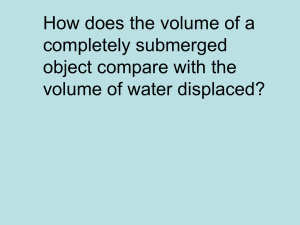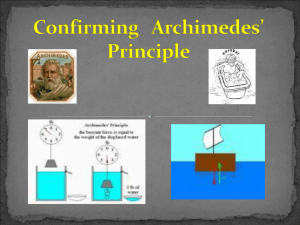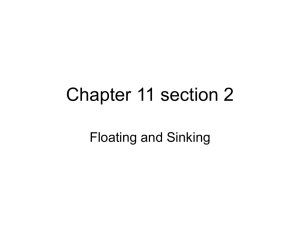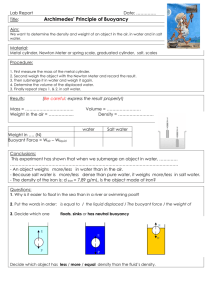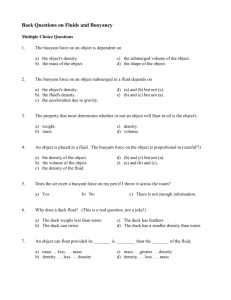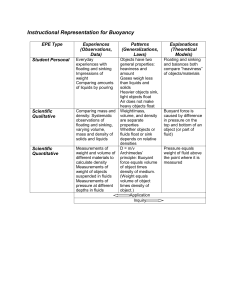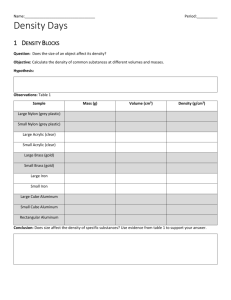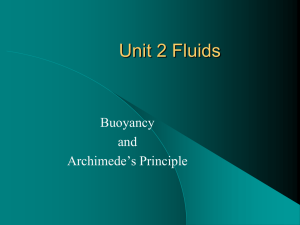ppt
advertisement
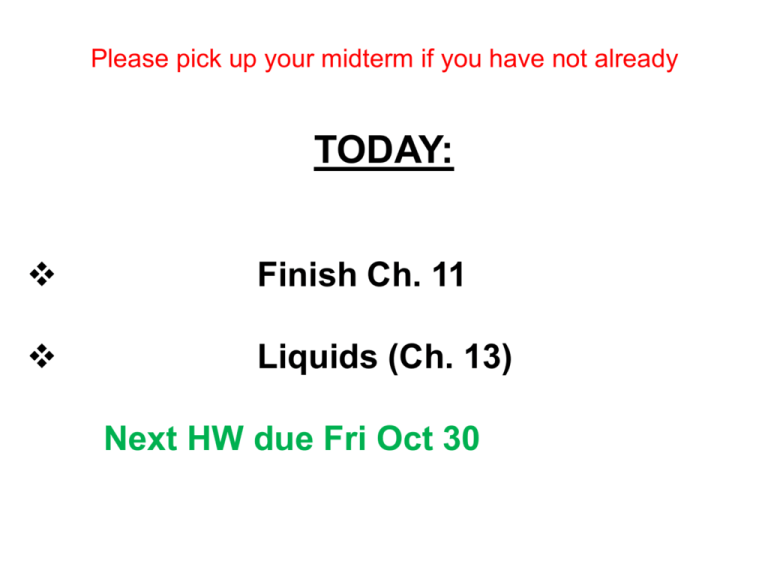
Please pick up your midterm if you have not already TODAY: Finish Ch. 11 Liquids (Ch. 13) Next HW due Fri Oct 30 Ch 13 (Liquids) First, concept of density (in Ch 12, everything else of which we are skipping) mass Density = volume Simply related by g = 9.8 N/kg Weight density = weight volume (near earth) Density measures how squished up the matter is, not how heavy it is Eg. A feather quilt may be heavier than a metal spoon, but the spoon is more dense than the quilt. Only if you have equal sizes (ie. volumes) of two materials, are their relative densities directly related to their weight. A little more on density… • Some densities: – Osmium (bluish-white metal) is the densest substance on earth. It’s an element (atomic # 76), whose crystalline form has very closely packed atoms. Density 22.6 g/cm3. Used e.g. in fountain pen tips, electrical contacts, where extreme durability/hardness needed. – Water has density 1 g/cm3 – Ice has less density, 0.92 g/cm3, because when water freezes, it expands. – Seawater has greater density, 1.03 g/cm3. Clicker Question Question: Which has greater density, 1 liter of water or 1 liter of ice? And which weighs more? A) The water has greater density and weighs more B) The water has greater density but weighs less C) The water has less density but weighs more D) The water has less density and weighs less Answer: A Any amount of water has greater density than any amount of ice (it doesn’t depend on amount, since density is the ratio of mass to volume). Since water has greater density, it weighs more than an equal volume of ice. Pressure • Why does it hurt so much more when a thumbtack pin is pressed into your hand than when a marble is, pressing equally hard ?? Even though the force in each case may be the same, one (the pin) acts over a much smaller area than the other (marble). So, define Pressure = force area Question: Why is a bed-ridden person less likely to develop bedsores on their bodies if they use a waterbed rather than an ordinary (i.e. more rigid) mattress? Because more of the body is in contact with the supporting surface on the waterbed than on the mattress, so there is less bodyweight pressure. (Larger area in eqn above, same force, so less pressure) Pressure in a liquid • A liquid is composed of molecules that move constantly and bounce off the sides of the container it is in and or bounce off objects (like a swimmer) in the liquid. Bouncing creates a force (recall momentum-impulse) – hence a pressure. due to liquid’s weight directly above Liquid Pressure = weight density x depth area x depth force weight weight density x volume “Proof”: Pressure = area = area = area = weight density x depth Pressure in a liquid: dependence on depth. • Pressure at a point twice as deep, is twice as much. • Consider swimming: Near top surface of the water, don’t feel much pressure (depth is near 0). (More precisely, need to add air pressure of the atmosphere but since it’s there all the time, we don’t notice that). Go deeper - you feel more pressure (e.g. in your ears). The deeper you go, the more weight of water is above you, so more pressure you feel. • It does not depend on the volume, only on the depth • Eg. Same water pressure felt when swimming 2m deep in a backyard pool than when swimming 2m deep in a huge freshwater lake. Eg. Different shaped vases all connected – the level of the water in each is the same. Why? Because, if not, the pressure would be more at the bottom of the vase with higher water level (from eqn, larger depth). This increased pressure would then force water sideways to lower pressure, and then up the vase with lower level. Eventually pressures equalize – which means same water level in each. This gives rise to the saying water “seeks it’s own level”. Question: Which pot holds more tea? (They are identical except that the left one is taller) The both hold the same! The water cannot be no deeper than the spouts, which are at the same height. Eg. Hold a garden hose filled with water, and hold both ends at same height, water stays. Now if raise one end, water flows out lower end, even through an “uphill” path. Relevant to the unnecessarily elaborate acqueducts the Romans made, very carefully ensuring water would flow downhill at all points – but actually water can flow upwards in between. Clicker Question There is more pressure felt by a swimmer at the bottom of A) The large but shallow lake B) The small but deep pond C)Same for both Answer: B The pressure at the bottom of the small but deep pond here is twice as great as the pressure at the bottom of the large shallow lake. Pressure in liquid: density dependence Recall: Liquid Pressure = weight density x depth • If liquid is twice as dense, the liquid pressure is also twice as much. Eg. Saltwater is more dense than fresh water (see earlier slide on density). So saltwater has more liquid pressure (makes it easier to float in the ocean than in a freshwater lake…see shortly for more on floating). • Liquids are very difficult to compress – so even for a large body of liquid, the density is practically the same at all depths. Liquid Pressure: Direction • Liquid pressure is exerted equally in all directions. Eg Swimming underwater, pressure on eardrum is same if tilt head in any direction. Eg. Water spurts sideways from holes in the side Eg. Boat on water – water pressure acts upward on the boat surface • Although force has direction, pressure does not (it’s a scalar) At any point on the triangular block shown, force from bouncing molecules are in all directions, but only that normal to the surface doesn’t get cancelled out. Net force is normal (perpendicular) to (any) surface. Buoyancy Buoyant force = upward force acting on an object in liquid, due to pressure on lower part of object being higher than pressure on upper part: Why? Because liquid pressure is larger for larger depths. Question: If there’s an upward buoyant force on a submerged object, then how come it doesn’t accelerate upwards (N’s 2nd law) ?? There are also other forces acting – downward gravitational force and water resistance. So whether it accelerates or not, and in which direction (up or down) depends on how these balance. Eg, if push a light ball under water, it accelerates up once you let go due to buoyant force being dominant. But if you push a boulder under water, it will sink, as weight (grav force) is larger than the buoyant force. Displacement: towards Archimedes principle First we need the concept of “volume of water displaced” A completely submerged object always displaces a volume of liquid equal to its own volume: If have container full of water, and then add a rock: Volume of water dripped out = volume of rock. Regardless of weight of rock – eg. a 1-liter container of milk and a 1-liter container of air submerged in water, both displace the same amount of water. If container is big: then increase in volume level = volume of rock Aside: Archimedes and the King’s Crown • This concept of displacement of water is really useful if you want to measure the volume of odd-shaped objects. • There is a story of how Archimedes (circa 250 BC) discovered this. King Hiero II had given a goldsmith a lump of pure gold of a certain weight to make him an elaborate crown. He then wanted to verify that the goldsmith did in fact use all the gold, and didn’t substitute part of a cheaper metal like silver, taking some of the gold for himself instead. How to determine this without destroying the crown? While taking a bath, Archimedes realized when an object is put in water, the water level rises an amount equal to the object’s volume (displacement principle). So: Can measure that the crown and gold ingot have the same weight. When put in water, the king’s crown displaced more water than the gold ingot larger volume lower density, i.e. not pure gold Buoyancy: Archimedes’ Principle An immersed body is buoyed up by a force equal to the weight of the fluid it displaces. • Applies to liquids and gases • Applies to either partially submerged objects or fully submerged objects • So buoyant force depends on object’s volume that is in the liquid Eg. What is the buoyant force on a 1-liter container of anything in water so that just half of it is in the water? Same volume, 0.5-liter, of water is displaced, so the buoyant force on it is the weight of 0.5-liters of water = 0.5 x 9.8 N = 4.9 N. Recall 1-liter of anything is 1000 cm3. Recall mass density of water is 1g/cm3, so weight density is 1xg = 9.8 N/cm3. So weight of 1 liter of water is 9.8 N. If fully submerged, the buoyant force is greater – equal to 9.8 N in the case of (any) 1-liter object. More on Archimedes Principle • For a fully submerged object, the buoyant force is independent of depth, even though the pressure depends on depth: The difference between the pressure at the bottom of the object and the pressure at the top is what causes the buoyant force. This difference is same at any depth – it just depends on how tall the object is. • Because of the buoyant force, apparent weight in water is less than weight in air: Here, the 3N object displaces an amount of water weighing 2N = buoyant force. So its weight in water is reduced to 1N. Clicker Question Upon which is the buoyant force larger – a fish that has eaten a huge meal, or its hungry identical twin? (Assume that the full fish holds its tummy in so that its volume is the same but its mass and density are greater). A) The fish who had its meal B) The hungry twin C) Same for both Answer: C The buoyant force is the same on each, since both fish have same volume so displace the same amount of water. Very Important!!! It’s the volume of the object that determines the buoyant force, not its weight! Eg. A small steel ball experiences less upward buoyant force than a large styrofoam ball. The steel ball sinks because its downward gravitational force is much bigger – Sink or float depends on the objects weight as well – next slide.. Sinking vs Floating • Depends on whether object’s weight is greater (sink) or less (float) than buoyant force. upward force downward force Since weight = weight density x volume, and buoyant force = fluid density x volume, then sinking vs floating depends on the relative density of the object to fluid: (i) If object denser than fluid, it will sink (ii) If object less dense than fluid, it will float (iii) If same density, then it will neither sink nor float. Eg. If you are too muscular, it’s hard for you to float in water, as you are too dense! Taking a huge breath to inflate your lungs could help to reduce your average density temporarily, or wear a life jacket – this increases your volume but decreases average density since it is so light. Example: Fish normally have about the same density as water (so neither sink nor float). They have an air sac that they can contract or expand. Question: If a fish wanted to swim upward, then what should it do with its air sac? How about if it wanted to move downward? To move up, want to increase buoyant force, so decrease density. Since density = mass/volume, this means increasing volume by expanding the air sac would make fish move up. To move down, contract air sac. Another point about the buoyant force: Something that may sink in water, may float in salt water (more dense), or in mercury (even more dense). Why? Because denser fluids have more weight for same volume displaced, so greater buoyant force. Hence, easier to float in ocean’s seawater than freshwater pool (recall earlier). And, iron floats in mercury but sinks in water… Clicker Question Consider holding a ping-pong ball and a golf ball of the same size under water. Then release them both. The ping-pong ball will rise to the surface whereas the golf-ball will fall. Why? A) B) C) D) E) The buoyant force is smaller on the golf ball than on the pingpong ball. Both the buoyant force and the gravitational force are larger on the golf ball than on the ping-pong ball due to its greater mass. The buoyant force is the same on both balls but less than the gravitational force for the golf ball and larger than the gravitational force for the ping-pong ball. More than one above is true None of the above is true Answer: C Flotation Since iron is more dense than water, how can ships made of iron float?? It’s because effective density is less since it is filled with air or lighter things: Iron has 8 x density of water, so if a block, it sinks. Instead, shape it into a boat, it displaces a greater volume of water ( in a sense, the boat has a larger effective volume). So greater buoyant force – when it equals its weight, it will no longer sink. “Principle of flotation”: A floating object displaces a weight of fluid equal to its own weight = buoyant force for floating objects. So, when building ships etc, need to make them wide enough. Clicker Question Which of the following is true for a ten-ton ship floating in salt water compared to floating in fresh water? A) The buoyant force is greater in the salt water, and there is more salt water displaced B) The buoyant force is greater in the salt water, and there is less salt water displaced C) The buoyant force is less in the salt water, and there is less salt water displaced D) The buoyant force is less in the salt water, and there is more salt water displaced E) The buoyant force is the same in salt water and fresh water, but there is more salt water displaced F) The buoyant force is the same in salt water and fresh water, but there is less salt water displaced Answer: F Since floating, buoyant force = weight =10 tons, whether in salt or fresh water. Since buoyant force = weight of liquid displaced, and density of salt water > density of fresh water, a smaller volume of salt water is displaced. Ship floats higher in salt water than in fresh water. Clicker Question The density of the block of wood floating in water is 1. greater than the density of water. 2. equal to the density of water. 3. less than half that of water. 4. more than half the density of water. 5. … not enough information is given. Answer: 4 Principle of flotation: A floating object displaces a weight of fluid equal to its own weight. Weight of displaced fluid = ¾ (densityof-water) x volume of block Weight = density x volume of block, so density-of-block = ¾ (density-of-water) A very-low-density object, like an inflated balloon, floats high on the water, and a denser object, like a piece of hardwood, floats lower into the water. An object half as dense as water floats halfway into the water (because it weighs as much as half its volume of water). Wood that floats 3/4 submerged, is 3/4 as dense as water—like the block in question—more than half the density of water. The density of the block compared to the density of water is the same as the fraction of the block below the water line. Pascal’s Principle A change in pressure at any point in an enclosed fluid at rest is transmitted undiminished to all points in the fluid. Eg: City water pipes: If pumping station increases pressure by certain amount, then pressure increases by that same amount in pipes throughout city. Pascal’s principle enables large weights to be lifted via small forces: Consider first simple U-tube: Pressure exerted downwards on left piston transmitted through tube to force right piston upwards – same pressure,same force. Now consider making right-side much wider. Same pressure change throughout means output force (= pressure x piston area) is larger by factor of the area. Hence large weights can be lifted by small forces. Idea behind hydraulic press. Simple machine: force multiplier (but same energy – distance moved up on right is less by factor of area than distance moved down on left) Surface tension • Surface of a liquid tends to contract – called surface tension. Liquid tries to minimize surface area. Example: But when raised, Paintbrush in water – hairs spread out, as they would if dry in air. • Surface tension is why liquid drops are spherical – surfaces tend to contract so force each drop into the shape with least surface area, ie a sphere (ball). Best seen with small drops, since gravity flattens larger ones. the surface film of the water contracts and pulls hairs together Surface tension cont. • Surface tension caused by molecular “sticky molecules” attractions: Below surface, molecule pulled by all neighbours, all directions equally. So no net pull. At surface, there are no molecules above, so net pull is downward into the liquid – leads to minimization of surface area. • Water – unusually high surface tension compared to common liquids. Soap or oil floating on water tends to get pulled out into a film entire surface, so to minimize surface area of the water. • Surface tension depends on temperature: Cold water – larger surf. tension than hot, since molecules don’t move as fast, so more strongly bonded. So in hot soups, oil or fat bubbles can form spherical droplets floating on top. When soup cools, the fat is drawn over the entire soup forming a film – “greasy soup”. Big reason why cold soup tastes different from hot! Capillarity • Another effect of “sticky molecules” in liquid – liquid tends to rise up thin (glass) tubes. The thinner the tube, the greater the rise. Called capillarity. How exactly does this work? Molecules stick more to glass than to themselves. adhesion So liquid drawn up to glass surface and then contracts. Steps: cohesion Height reached is determined by balance between upward adhesive force and downward grav. force on column • Responsible for why if one end of a towel hangs down into water, it soaks upwards • Essential for plants – how they get the water from the ground into roots and sap up to high branches Compared to an empty ship, will a ship loaded with a cargo of Styrofoam float lower in water or higher in water? 1. Lower in water 2. Higher in water Answer: 1, Lower in water Principle of Flotation: A floating object displaces a weight of fluid equal to its own weight. Ship with cargo weighs more, so will displace more water, i.e. float lower in water. A ship will float highest when its weight is least—that is, when it is empty. Loading any cargo will increase its weight and make it float lower in the water. Whether the cargo is a ton of Styrofoam or a ton of iron, (i.e. same weight), the water displacement will be the same. An astronaut on Earth notes that in her soft drink an ice cube floats with 9/10 its volume submerged. If she were instead in a lunar module parked on the Moon, the ice in the same soft drink would float with 1. less than 9/10 submerged. 2. 9/10 submerged. 3. more than 9/10 submerged. Answer: 2 How much a floating object extends below and above the liquid depends on the weight of the object and the weight of the displaced fluid, both of which are proportional to g. Lower g or increase it; the proportion floating above and below is unchanged.
